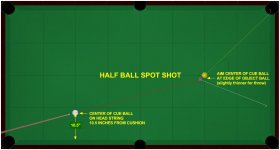Aiming at both pocket points would be most useful to those players who are using CP2CP or by those who are using the ghost ball.
What I'm suggesting for you to try is the use of both pocket points for aiming. Aim to hit the nearest pocket point first. This would be a slight undercut.
Next move your aim to the far pocket point. This would be a slight overcut. Shift your aim line back and forth from nearest to the farthest pocket point.
The difference between the aim points that will hit either pocket point is very small... but it's also the exact spot that you'll need to contact the OB.
This way of aiming probably won't work if you're aiming at ball shadows, overhead light reflections or some invisible spot on the table.
Flame on
.
What I'm suggesting for you to try is the use of both pocket points for aiming. Aim to hit the nearest pocket point first. This would be a slight undercut.
Next move your aim to the far pocket point. This would be a slight overcut. Shift your aim line back and forth from nearest to the farthest pocket point.
The difference between the aim points that will hit either pocket point is very small... but it's also the exact spot that you'll need to contact the OB.
This way of aiming probably won't work if you're aiming at ball shadows, overhead light reflections or some invisible spot on the table.
Flame on
.
